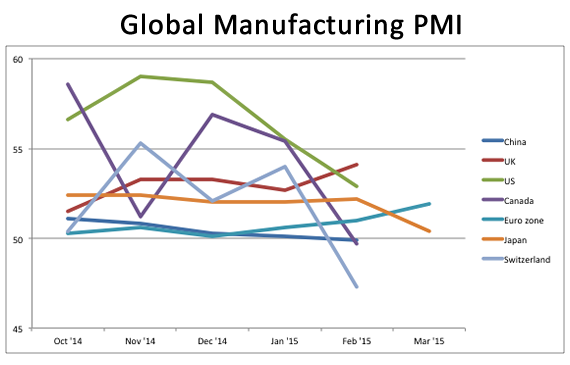Now that most major economies have released their manufacturing PMI readings, let’s take a look at whether trends are improving or not and what this could mean for their respective currency’s forex price action.
But first, for the newbies just tuning in, here’s a crash course on what the PMI or purchasing managers index is all about and why it matters. Simply put, the PMI is a gauge of business conditions in an industry, be it in manufacturing or services or construction. This is based on a survey conducted among purchasing managers, asking them to rate the level of employment, new orders, inventory, deliveries and other business-related indicators during the period.
A PMI reading above 50.0 indicates industry expansion and optimism among businessmen, which is generally reflected in improving economic data later on. Conversely, a PMI reading below 50.0 indicates industry contraction and pessimism among purchasing managers, which usually translates to weaker economic figures down the line.
Now here’s how the manufacturing PMI readings have turned out for most major economies for the past months:

Woah, that’s a lot of colorful lines right there! Lemme break it down for y’all.
First up, let’s focus on the lines that are moving higher, as these show that the manufacturing industries in those countries are seeing a faster pace of expansion. If my eyes ain’t deceiving me, I’m seeing improvements in the U.K. (red line) and in the euro zone (turquoise line). Ha, it looks like ECB Governor Draghi was on to something when he claimed that a “sustained recovery” is taking hold in the region!
And now for the rest of the major economies which seem to be undergoing a downturn in manufacturing… Switzerland (light blue line) and Canada (purple line) appear to have suffered a sharp deterioration in manufacturing conditions, as their readings have also dipped below the 50.0 mark in February after previously reflecting industry expansion. Growth in China’s (blue line) and Japan’s (orange line) manufacturing sector has gradually slowed down while the U.S. (green line) has taken it down a few notches as well.
With the manufacturing PMI typically considered a leading indicator of economic conditions such as hiring and spending, forex price action of these currencies might be in for the same trends in the next few weeks or months. Do you think this could be the case? Or will other indicators have a bigger say in market movements?
Recommended Content
Editors’ Picks
EUR/USD flirts with 1.0700 post-US PMIs

EUR/USD maintains its daily gains and climbs to fresh highs near the 1.0700 mark against the backdrop of the resumption of the selling pressure in the Greenback, in the wake of weaker-than-expected flash US PMIs for the month of April.
GBP/USD surpasses 1.2400 on further Dollar selling

Persistent bearish tone in the US Dollar lends support to the broad risk complex and bolsters the recovery in GBP/USD, which manages well to rise to fresh highs north of 1.2400 the figure post-US PMIs.
Gold trims losses on disappointing US PMIs

Gold (XAU/USD) reclaims part of the ground lost and pares initial losses on the back of further weakness in the Greenback following disheartening US PMIs prints.
Here’s why Ondo price hit new ATH amid bearish market outlook Premium

Ondo price shows no signs of slowing down after setting up an all-time high (ATH) at $1.05 on March 31. This development is likely to be followed by a correction and ATH but not necessarily in that order.
Germany’s economic come back

Germany is the sick man of Europe no more. Thanks to its service sector, it now appears that it will exit recession, and the economic future could be bright. The PMI data for April surprised on the upside for Germany, led by the service sector.